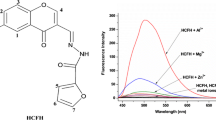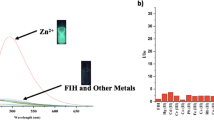Abstract
Organic fluorescence sensor for selectively detecting and quantifying toxic heavy metal ions has received significant interest due to their environmental hazards. Herein, we have designed and synthesized a simple tripodal Schiff base ligand (1) based on hydroxy-naphthaldehyde and tris(2-aminoethyl)amine (TREN) and demonstrated highly selective turn-on fluorescence sensing of Cd2+ ions. The free ligand did not show any fluorescence in DMF. In contrast, Cd2+ (10− 4 M) addition exhibited a strong enhancement of fluorescence at 450 nm. Interestingly, other metal ions including Zn2+, which exhibit similar chemistry, did not show any turn-on fluorescence. The concentration-dependent studies of 1 with Cd2+ showed the detection limit of 6.78 × 10− 8 M. NMR spectra of 1 with Cd2+ and computational studies were performed to understand the mechanism of sense.
Graphical Abstract










Similar content being viewed by others
Data Availability
The manuscript data is available with the corresponding authors and the same is available upon request.
References
Rasheed T, Bilal M, Nabeel F, Iqbal HMN, Li C, Zhou Y (2018) Fluorescent sensor-based models for the detection of environmentally-related toxic heavy metals. Sci Total Environ 615:476–485. https://doi.org/10.1016/j.scitotenv.2017.09.126
Saleem M, Lee KH (2015) Optical sensor: a promising strategy for environmental and biomedical monitoring of ionic species. RSC Adv 5:72150–72287. https://doi.org/10.1039/C5RA11388A
Valeur B, Leray I (2000) Design principles of fluorescent molecular sensors for cation recognition. Coord Chem Rev 205:3–40. https://doi.org/10.1016/S0010-8545(00)00246-0
De Silva AP, Gunaratne HQN, Gunnlaugsson T, Huxley AJM, Mc Coy CP (1997) Signalling recognition events with fluorescent sensors and switches. Chem Rev 97:1515–1566. https://doi.org/10.1021/cr960386p
Xu Z, Li G, Ren YY et al (2016) Selective fluorescent probe for the detection of Cd2+ in different buffer solutions and water. Dalton Trans 45:12087–12093. https://doi.org/10.1039/C6DT01398H
Chaney RL, Ryan JA, Li YM, Brown SL (1999) In: McLaughlin MJ, Singh BR (eds) Cadmium in soils and plants. Kluwer Boston, pp 219–256
Kim HN, Ren WX, Kim JS, Yoon J (2011) Fluorescent and colorimetric sensors for detection of lead cadmium, and mercury ions. Chem Soc Rev 41:3210–3244. https://doi.org/10.1039/C1CS15245A
Waisberg M, Joseph P, Hale P, Beyersmann D (2003) Molecular and cellular mechanisms of cadmium carcinogenesis. Toxicology 192:95–117. https://doi.org/10.1016/s0300-483x.(03)00305-6
Akesson A, Julin B, Wolk A (2008) Long-term dietary cadmium intake and postmenopausal endometrial cancer incidence: a population-based prospective cohort study. Cancer Res 68(15):6435–6441. https://doi.org/10.1158/0008-5472.CAN-08-0329
Bridges CC, Zalups RK (2005) Molecular and ionic mimicry and the transport of toxic metals. Toxicol and Appl Pharmacol 204(3):274–308. https://doi.org/10.1016/j.taap.2004.09.007
Cadmium (2008) Guidelines for drinking-water quality, vol 1. WHO, Geneva, pp 317–319
Baba H, Tsuneyama K, Yazaki M et al (2013) The liver in itai-itai disease (chronic cadmium poisoning): pathological features and metallothionein expression. Mod Pathol 26(9):1228–1234. https://doi.org/10.1038/modpathol.2013.62
Aoshima K (2016) Itai-itai disease: renal tubular osteomalacia induced by environmental exposure to cadmium-historical review and perspectives. Soil Sci Plant Nutr 62(4):1–8. https://doi.org/10.1080/00380768.2016.1159116
Zhu H, Tan X, Tan L et al (2018) Magnetic porous polymers prepared via high internal phase emulsions for efficient removal of Pb2+ and Cd2+. ACS Sustain Chem Eng 6(4):5206–5213. https://doi.org/10.1021/acssuschemeng.7b04868
Wang W, Wu M, Liu H, Liu Q, Gao Y, Zhao B (2019) A novel on-off-on fluorescent chemosensor for relay detection of Fe3+ and PPi in aqueous solution and living cells. Tet Lett 60(25):1631–1635. https://doi.org/10.1016/j.tetlet.2019.05.015
Wang S, Ma L, Liu G, Pu S (2019) Diarylethene-based fluorescent and colourimetric chemosensor for the selective detection of Al3+ and CN–. Dyes Pigm 164:257–266. https://doi.org/10.1016/j.dyepig.2019.01.029
Hariharan PS, Anthony SP (2014) Selective turn-on fluorescence for Zn2+ and Zn2+ + Cd2+ metal ions by single Schiff base chemosensor. Anal Chim Acta 848:74–79. https://doi.org/10.1016/j.aca.2014.07.042
Kundu A, Hariharan PS, Prabakaran K, Anthony SP (2015) Developing new Schiff base molecules for selective colorimetric sensing of Fe3+ and Cu2+ metal ions: Substituent dependent selectivity and colour change. Sens Actuators B 206:524–530. https://doi.org/10.1016/j.snb.2014.09.099
Wang JH, Liu YM, Chao JB et al (2020) A simple but efficient fluorescent sensor for ratiometric sensing of Cd2+ and bioimaging studies. Sens Actuators B 303:127216–112722. https://doi.org/10.1016/j.snb.2019.127216
Chithiraikumar S, Balakrishnan C, Neelakantan MA (2017) Tuning ligand vicinity towards the development of “turn-on” fluorescence for cadmium(II) ions under physiological pH and bioimaging. Sens Actuators B 249:235–245. https://doi.org/10.1016/j.snb.2017.04.106
Sun J, Ye B, Xia G, Wang H (2017) A multi-responsive squaraine-based “turn on” fluorescent chemosensor for highly sensitive detection of Al3+, Zn2+ and Cd2+ in aqueous media and its biological application. Sens Actuators B 249:386–394. https://doi.org/10.1016/j.snb.2017.03.134
Liu H, Cui S, Shi F, Pu S (2018) A diarylethene-based multi-functional sensor for fluorescent detection of Cd2+ and colorimetric detection of Cu2+. Dyes Pigm 161:34–43. https://doi.org/10.1016/j.dyepig.2018.09.030
Garau A, Lvova L, Macedi E et al (2020) N2S2 pyridinophane-based fluorescent chemosensors for selective optical detection of Cd2+ in soils. New J Chem 44:20834–20852. https://doi.org/10.1039/D0NJ03858J
Bhagat DS, Pawar RP, Tekale AB et al (2019) Green synthesis of an amide-based chemosensor and its application for detection of toxic metal ions. Eur Chem Bull 8(9):212–215. https://doi.org/10.17628/ecb.2019.8.212-215
Wan X, Ke H, Tang J et al (2019) Acid environment-improved fluorescence sensing performance: a quinoline Schiff base-containing sensor for Cd2+ with high sensitivity and selectivity. Talanta 199:8–13. https://doi.org/10.1016/j.talanta.2019.01.101
Ravichandiran P, Czubara AB, Masłyk M et al (2019) A phenoxazine-based fluorescent Chemosensor for Dual Channel detection of Cd2+ and CN– ions and its application to Bio-Imaging in Live cells and zebrafish. Dyes Pigm 172:107828–107835. https://doi.org/10.1016/j.dyepig.2019.107828
Park S, Kim H-J (2012) Reaction-based chemosensor for the reversible detection of cyanide and cadmium ions. Sens Actuators B 168:376–380. https://doi.org/10.1016/j.snb.2012.04.040
Kumar AS, Ahmed N (2017) Coumarin–chalcone hybrid as a selective and sensitive colorimetric and turn-on fluorometric sensor for Cd2+ detection. New J Chem 41:14746–14753. https://doi.org/10.1039/C7NJ02569F
Khan SA, Ullah Q, Almalki ASA et al (2021) Synthesis and photophysical investigation of (BTHN) Schiff base as off-on Cd2+ fluorescent chemosensor and its live cell imaging. J Mol Liquids 328:115407–115414. https://doi.org/10.1016/j.molliq.2021
Hassan HB (2014) Density function theory B3LYP/6-31G**Calculation of geometry optimization and energies of Donor-Bridge-Acceptor molecular system. Int J Curr Engg Tech 4(4):2342–2345 (E-ISSN)
Bourass M, Benjelloun AT, Benzakour M et al (2016) DFT and TD-DFT calculation of new thienopyridine-based small molecules for organic solar cells. Chem Cent J 10(67):1–12. https://doi.org/10.1186/s13065-016-0216-6
Eroshin AV, Otlyotov AA, Kuzmin IA et al (2022) DFT study of the molecular and electronic structure of metal-free tetrabenzoporphyrin and its metal complexes with Zn, Cd, Al, Ga. Int J Mol Sci 23(2):939–951. https://doi.org/10.3390/ijms23020939
Zhang Y, Guo XF, Zheng LB, Jia LH (2017) A novel red-emission sulfonamidoquinoline-based sensor with visible excitation for sensing group IIB cations. J Lumin 188:283–288. https://doi.org/10.1016/j.jlumin.2017.04.039
Ding XH, Zhang FF, Bai YJ, Zhao JX, Chen X, Ge M, Sun W (2017) Quinoline-based highly selective and sensitive fluorescent probe specific for Cd2 + detection in mixed aqueous media. Tetrahedron Lett 58:3868–3874. https://doi.org/10.1016/j.tetlet.2017.08.068
Lu ZN, Wang L, Zhang X, Zhu ZJ (2019) A selective fluorescent chemosensor for Cd2+ based on 8-hydroxylquinoline-benzothiazole conjugate and imaging application. Spectrochim Acta Part A 213:57–63. https://doi.org/10.1016/j.saa.2019.01.041
Li SL, Cao DL, Ma WB et al (2020) A simple fluorescent probe for detection of Ag+ and Cd2+ and its Cd2+ complex for sequential recognition of S2–. RSC Adv 10:18434–18439. https://doi.org/10.1039/D0RA01768J
Xiao Y, Ma J, Li DH, Liu L, Wang HL (2020) Preparation 4’-Quinolin-2-yl-[2, 2’; 6’, 2”] terpyridine as a ratiometric fluorescent probe for cadmium ions and zinc ions in aqueous. J Photochem Photobiol A 399:112613. https://doi.org/10.1016/j.jphotochem.2020.112613
Paul S, Banerjee P (2021) An ESIPT based turn on fluorochromogenic sensor for low level discrimination of chemically analogous Zn2+ and Cd2+ & aqueous phase recognition of bio-hazardous CN–: from solution state analysis to prototype fabrication. Sens Actuators B 329:129172. https://doi.org/10.1016/j.snb.2020.129172
Inal EK (2020) A fluorescent Chemosensor based on Schiff Base for the determination of Zn2+, Cd2+ and Hg2+. J Fluoresc 30:891–900. https://doi.org/10.1007/s10895-021-02818-w
Funding
Financial support from the Science and Engineering Research Board (SERB), Core Research grant (CRG) (CRG/2020/003978) and DST-FIST (SR/FST/CS-1/2018/62), New Delhi, India is acknowledged with gratitude. Dr BJ sincerely thanks DST-SERB (File No.: SB/FT/CS-169/2012) and DST-DPRP division [File no: VI-D&P/562/2016-17/TDT (C)].
Author information
Authors and Affiliations
Contributions
P.M and S. A performed the synthesis and characterization and S.R and P.G carried-out sensing studies and C.E and R.V.S performed theoretical studies and B.J and S.P.A planned the work and wrote the main manuscript.
Corresponding authors
Ethics declarations
Ethical Approval
Not applicable.
Conflict of Interests
The authors declare no competing interests.
Additional information
Publisher’s Note
Springer Nature remains neutral with regard to jurisdictional claims in published maps and institutional affiliations.
Rights and permissions
Springer Nature or its licensor (e.g. a society or other partner) holds exclusive rights to this article under a publishing agreement with the author(s) or other rightsholder(s); author self-archiving of the accepted manuscript version of this article is solely governed by the terms of such publishing agreement and applicable law.
About this article
Cite this article
Muralakar, P., Ravi, S., Gayathri, P. et al. Highly Selective Turn-on Fluorescence Sensor for Cd2+ Ions by Tripodal Organic Ligand. J Fluoresc 34, 1229–1240 (2024). https://doi.org/10.1007/s10895-023-03348-3
Received:
Accepted:
Published:
Issue Date:
DOI: https://doi.org/10.1007/s10895-023-03348-3




